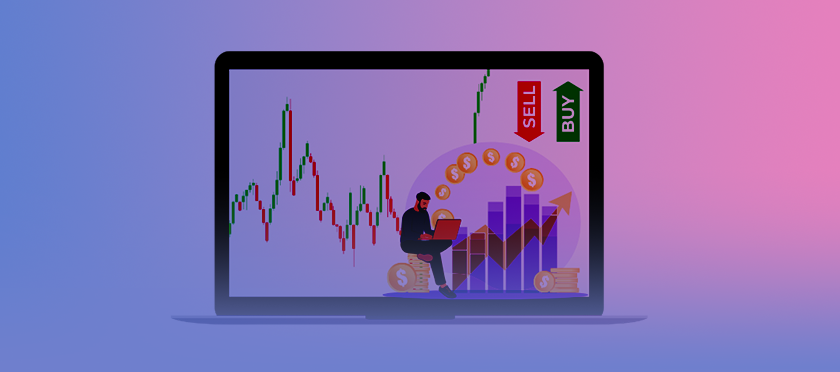Day Trading Basics: Making Your Dollars Work for You
Day trading seems like the perfect job. You start work at 9:30 AM and quit at 4:30 PM. You’ve seen the day traders with the fancy cars and vacation homes on the beach. You’re an intelligent person. Surely you can do the same. However, day trading is stressful and very risky. You’re not just battling the market. You’re competing with other day traders. You win when they lose.
Day trading isn’t the same as traditional investing. The goal might be to make money in both cases, but day traders typically target a 10% profit per month versus 15% per year.
‣ DIFFERENCES BETWEEN LONGER TERM INVESTING AND DAY TRADING
There are several other differences between day trading and conventional investing:
1. Day traders complete their buying and selling activities within a single day. A conventional investor might buy and hold a security for decades. A day trader will close out his positions by the end of each day. The next day is a fresh start.
2. Day trading has less risk in some circumstances. A day trader can’t wake up the next day and discover that he’s lost everything. Many investors have awakened to a rude surprise after earnings reports were released.
‣ Conventional traders have the advantage of time. They don’t have to take a loss just because the stock is down for a day. They have the luxury of waiting to see if things turn around. Over time, the markets are efficient, and your research will pay off if done correctly.
3. Investors and day traders research stocks differently. The way an investor chooses a stock for a long-term investment is of no value to a day trader. Day traders are more concerned with volume, pre-market activity, and social signals than with profits, debt, and long-term prospects.
4. Investing requires far less time. With longer term investing, it’s possible to choose a few stocks, check on them periodically, and make the necessary adjustments as you go along. Day trading is fast and furious. Each trade typically yields a small profit or loss. It requires a lot of trading to make a significant amount of money. Day trading is a full-time job.
You might be a skilled investor but lack the knowledge and temperament to be a successful day trader. Be sure to investigate the subject thoroughly before taking the plunge. There are many simulated day trading platforms. You can try your luck with imaginary money and see how your skills stack up.
‣ DAY TRADERS CHOOSE STOCK DIFFERENTLY THAN INVESTORS:
1. Day traders focus on stocks with high volatility. These are stocks with relatively wide swings in price over a short period of time. Volatility can have several causes. High dependence on the value of a foreign currency or high variability in the company’s underlying cash flows are two examples.
2. Day traders also prefer stocks with high liquidity. These are stocks that are easy to buy and sell. These stocks also tend to be available at a higher discount than stocks with less liquidity. These are usually stocks with higher capitalization rates. Overpriced stocks are more easily picked up at a discount relative to the average price.
3. Trading volume is important to day traders. Volume refers to the number of shares bought and sold in a single tradingday. The Trading Volume Index, or TVI, can provide insight into trading volume. It also indicates how much money is flowing into or out of a particular stock.
Choosing stocks for day trading is surprisingly complicated. Entire books have been dedicated to single trading strategies. If you’re interested in day trading, it would be worthwhile to spend time doing as much research as you can to become familiar with a strategy you would be comfortable with.
Regular investing strategies are different from day trading strategies. You might spot a few similarities, but the timeframes are completely different.
‣ DAY TRADING STRATEGIES
Though there are several strategies a day trader can adopt, there are four primary strategies:
1. Fading. Fading is an attempt to profit from a temporary rise in a stock price due to a heavy period of buying. The day trader shorts the stock with the expectation that the stock will fall when other day traders and investors dump the stock.
2. Momentum. Momentum relies on news and social signals and the anticipation that the stock price will react strongly to the news.
3. Daily Pivots. Traders purchase the stock at the expected low of the day, based upon their research. They then attempt to sell at the expected high of the day.
4. Scalping. Scalping is the taking of small profits. As soon as a trade is profitable, the day trader closes out his position. Profits are limited, but the risk is lower. This is one of the more common strategies, particularly among new traders. Most of the more complex day trading strategies will still fall into one of these four basic types. It’s important to have a well-planned and understood strategy. Day trading requires precision and discipline.
‣ TOOLS FOR DAY TRADING
Day trading requires a few tools:
1. Trading software. There are many options. A few of the more popular offerings are provided by E-Trade, TD Ameritrade, Scottrade, and Fidelity. Trading software is the interface used to execute buy and sell orders. The trader sets the criteria and the software automatically executes the trades when the criteria are met.
The brokerage service you select will provide a trading interface.
2. Charting software. Charting software provides market data in a graphical format. If you’ve ever seen a day trader staring at multiple computer screens, he was probably looking at his charting software. Sierra Chart and ESignal are two popular charting packages.
3. Computer. At a minimum, a modern laptop is required. Some traders have custom computers built, but this is hardly necessary. You might require a custom setup or multiple computers if you wish to view eight screens simultaneously.
4. Internet access and a second source of internet access. You might find yourself in quite a pickle if your internet access fails at the wrong time. Cell phone providers are one source of backup internet service, but their service can be slow.
It doesn’t take much to get started. If you already invest, you’ll only need charting software to round out your tool box.
‣ GETTING STARTED – A WORD TO THE WISE
Day trading can be exciting and highly lucrative. Day trading has also been the cause of more than a few suicides. Tread carefully. Many other investors have the same idea. It can take years of experience to become a skilled day trader. Take your time and get start slowly. Avoid risking more money than you can afford to lose.
This method of making money is highly competitive. You’ll be up against thousands of Ivy League MBAs with killer instincts. Can you compete? There’s only one way to find out. For best results, try a simulation first.




